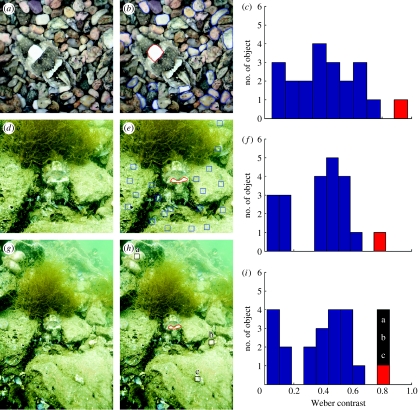Figure 4.
Certain skin components of cuttlefish, S. officinalis, have higher contrast than objects in the surrounds. (a) A cuttlefish showing disruptive body pattern on pebble background in the laboratory. (b) White square on the mantle (red) and 20 light objects in the surrounds (blue) were selected for computing their Weber contrasts. (c) The distribution of Weber contrasts for all 21 selected areas in (b). Weber contrast was determined by (MIobject−MIbackground)/MIbackground, where MIobject is the mean intensity of the selected area and MIbackground is the mean intensity of the entire image. Note that the red bar corresponds to the Weber contrast of the white square, and it is the highest one among all other selected areas. (d) A cuttlefish showing distinct disruptive components (white square and white head bar) on a natural habitat in Turkey. (e) White head bar (red) and 20 randomly selected equivalent-sized areas in the surrounds (blue boxes) were chosen for computing their Weber contrasts. (f) The distribution of Weber contrasts for all 21 selected areas in (e). Similarly, the Weber contrast of the white head bar is higher than other areas in the surrounds. (g) The same animal shown in (d), but with a wider view. (h) Besides the 20 areas selected in the surrounds, three more light areas (black boxes) were chosen for computing their Weber contrasts. (i) The distribution of Weber contrasts for all 24 selected areas in (e) and (h), including three areas in the periphery (a–c). In a wider view, there are other areas having similar or even higher Weber contrast than the disruptive component of the animal.

